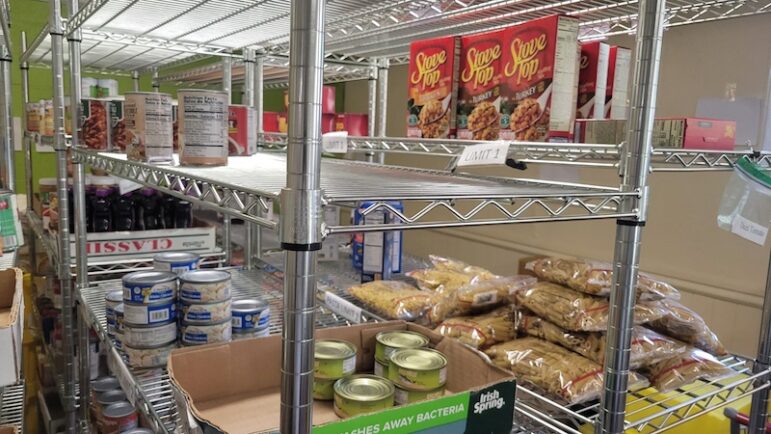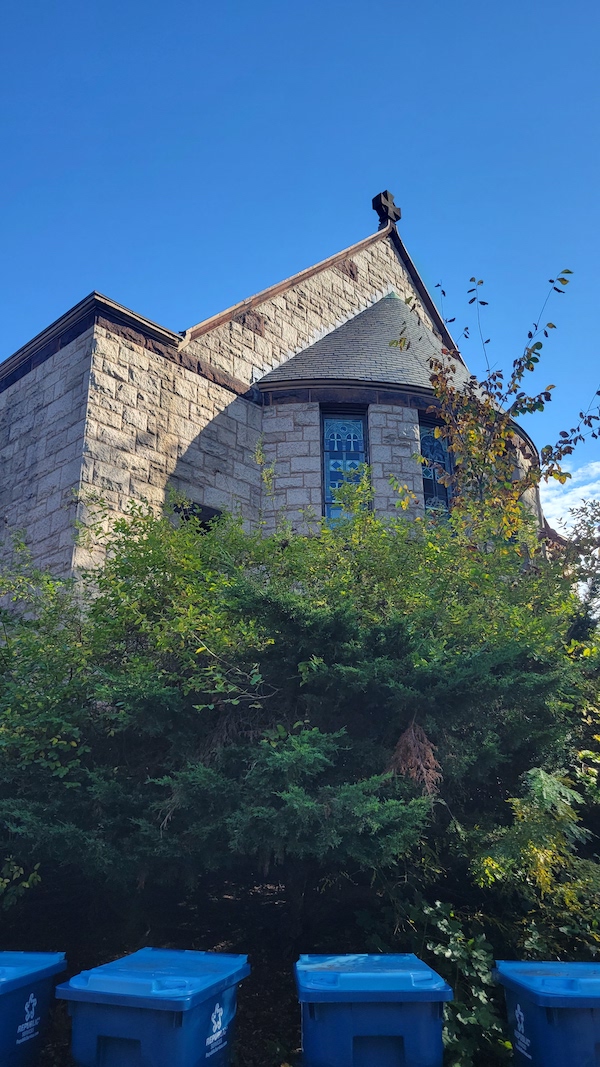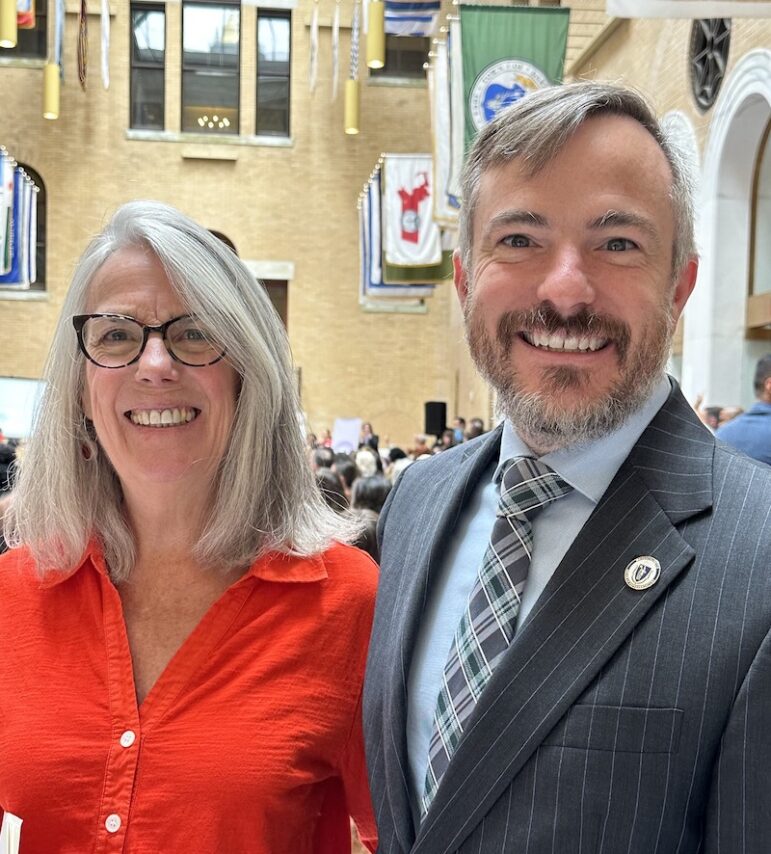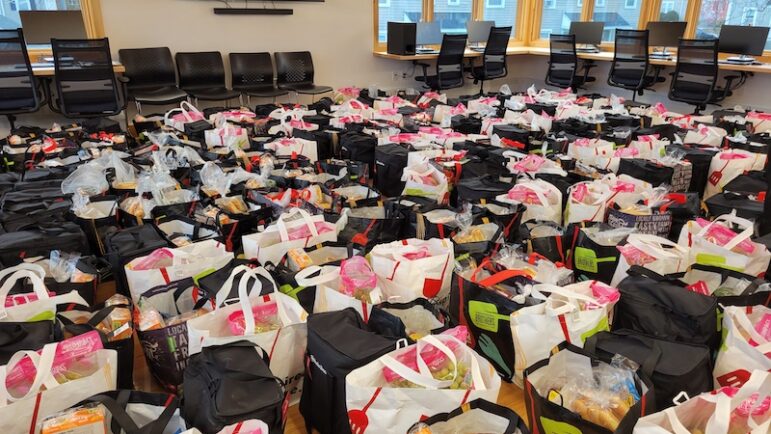
For many, Watertown is a destination for food and eating, with dozens of restaurants, markets small and large, and a farmers market through the warmer months. However, a significant number of residents have trouble affording to feed themselves and their families.
The hunger problem in Watertown is often not visible, but those who provide assistance and services to people in need have noticed a recent increase in the number of people in town facing food insecurity, spiking during the Pandemic. And, while the COVID cases have dropped, the numbers of people going to Watertown’s two food pantries, or needing help to put enough food on their table has remained at about the same level.
Watertown has found some ways to help people have enough to eat, both traditional efforts, including Food Pantries, and new ones, such as the Community Fridge and programs funded by the Watertown Community Foundation to deliver food to some of the City’s most vulnerable residents. Some of these programs, however, will be coming to an end as post-Pandemic funds dry up.
Watertown News and Watertown Cable Access Television joined forces to look back at the rise in food insecurity, speaking to those making use of the local and state food insecurity programs, the people on the front lines providing help, and sought to find out what else can be done. This story is the first in a six-part series on food insecurity, and Watertown Cable will be producing a series of programs looking at the issue airing at a later date. The series is made possible, in part, by a grant provided by the Watertown Community Foundation.
The Pandemic Spike
The Pandemic brought some issues in Watertown into focus, said Jan Singer, the former executive director of the Watertown Community Foundation.
At the dawn of the COVID-19 Pandemic, Singer remembers gathering her board members to workout how the organization could help the community weather the Pandemic. They looked at ways to provide COVID kits to those who had tested positive, computers for families who needed it so their children could participate in remote learning, and emergency funds for things like rent, utilities, and food.
Food insecurity was not unknown before March 2020, Singer said, who said the WCF was working with the Watertown Public Schools to send students home with backpacks full of food for the weekend. The program was aimed at children of families in the Watertown Public Schools who qualified for the free lunch through the federally funded National School Lunch Program.
“We had a special grant for this from the Perpetual Benevolent Fund,” she said. “We brought their board members in to see how we were doing it and what was going on, so food insecurity was an issue long before the Pandemic and when the Pandemic hit it just exacerbated it and it has not stopped.”
Kathy Cunningham, coordinator of the Watertown Food Pantry, said she has seen many more people use the pantry in the last few years.
“So, when I first began here, we were doing 40 families a week …” Cunningham said. “And then it graduated up to probably 70 families, and then once the pandemic hit, we were running approximately 200 families every single day that we were open, which was okay. It was fine. We made sure that we did a lot of outreach. We had a lot of feeder programs. We were never without, we never let anybody go hungry or anything on that level.”
After people got back to work and things began to return to normal after the Pandemic, the number of families the Watertown Food Pantry served began to decline, but did not return to previous numbers.
“So after the COVID and things are starting to get back to normal, such as the children attending school, I would say we probably leveled off at around 180 a week, for probably six, seven months at least,” Cunningham said. “And now we’re averaging between 140, 160 each week.”
The Watertown Food Pantry, located in the basement of the former Methodist Church near Watertown Square at 80 Mt. Auburn St., is one of two pantries in town and is open on Tuesdays from 10 a.m. to 2 p.m. The other is run by the Catholic Collaborative in the basement of Sacred Heart Church, 770 Mt. Auburn St. in East Watertown on Thursdays from 10 a.m. to 11:45 a.m.
During the Pandemic, another food source became available, a grass-roots community effort called the Watertown Community Fridge. This started near Francis Market on Belmont Street, and then moved to the same church that houses the Watertown Food Pantry. Food is put in the fridge, an is available for free to anyone. Also, people can donate fresh, frozen, and non-perishable items.

Who is coming into the pantry? Cunningham said she has seen all sorts of people come in.
“I do have to say it can be anybody, anybody can be coming. You could be owning a home here. You could be not having a home at all here, lots of homeless. More so than when I first began here,” said Cunningham who took over the Food Pantry coordination in May 2017.
The exact numbers of people facing food insecurity in Watertown is not known. Stephanie Venizelos has some idea of the magnitude of people who qualify for SNAP benefits (formerly known as Food Stamps). In her position as the City of Watertown’s Community Wellness Program Manager for the City of Watertown, she also runs the Watertown Farmers Market and Live Well Watertown. Vendors at the Farmers Market take SNAP and Venizelos tries to publicize the discounts, and matching dollars available for SNAP users at the Farmers Market.
“We know in Watertown we have about 9 percent of people using SNAP benefits and we’ve got at least that amount, if not a little more, who qualify but aren’t enrolled,” she said. “We call that the SNAP gap.”
With an estimated population of just over 35,000 in 2022, according to the U.S. Census Bureau, that would be 3,150 people on SNAP benefits, with about the same number eligible but who have not signed up.
During the Pandemic, food insecurity more than doubled nationwide, Venizelos said, “and we saw an increase in Watertown.”
Those in need of help in Watertown often find their way to the Wayside Multi-Service Center on North Beacon Street. One of the programs run by the center is the Social Services Resource Specialist, or SSRS, program, which is funded by the City of Watertown to serve residents age 18-59.
Sophia Suarez-Friedman splits the responsibilities with her colleague, Maysa Ramos. They provide assistance, or refer people to various resources available in Watertown, including food insecurity, as well as rental assistance, programs for utilities, mental health, substance abuse, and more. The needs
“I think there were certain needs that were high before the pandemic and that was typically housing, and those needs spiked during the Pandemic and have remained high in terms of food,” Suarez-Friedman said.
The SSRS program tracks how many households the program serves each quarter.
“I was looking at quarter 1 in 2020, that’s January through March 2020, we served less than 10 households for access to food and then ever since April 2020 it has been between 30 and 60 households,” Suarez-Friedman said. “We have been supporting with food, it’s typically high-40s, mid-50s households we are supporting and that has just not gone down.”
The Pandemic brought additional benefits provided by the Federal and State governments, but those have ended as the Pandemic waned.
“People are continuing to struggle because costs overall have increased, cost of food has increased, and they are getting less benefits through their SNAP benefits, so that’s why the need really feels high, still,” Suarez-Friedman said.
The Watertown Public Schools have two Community Outreach Counselors, Jaimie Swift and Stephanie Toyias, who help students and their families get access to resources including SNAP benefits, housing assistance, medical referrals and other assistance. They have seen the need grow in recent years,
“Last year we worked with about 150 families, and this year our projections are quite a bit higher so we are probably thinking around 180 this year, ” Swift said, who said that includes families which may just need help on one issue, and others that need more ongoing support.
Oftentimes the biggest concern for families is the cost of housing, but Toyias said that often leads to other issues, including food insecurity.
“It usually goes hand in hand,” Toyias said. Swift added that about 60 to 70 percent of the families they work with have food insecurity at some level.
Community Based Help
When the Pandemic hit, Watertown was in a unique position for a city of its size, Singer said. A private foundation, the Massachusetts COVID-19 Relief Fund, made grant funds available only to community foundations, and Watertown’s is one of about 15 in Massachusetts, Singer said, and one of the smallest.
“We were lucky enough to be part of that at the very beginning,” she said. “In the beginning it was a small amount, but then the state stepped in and had major funding and we became recipients of that funding. Along with that funding we were able to distribute money for, first of all, housing, childcare, and also for food security.”

Since 2020, the Watertown Community Foundation has distributed more than $750,000 to meet the urgent needs of families struggling with food security, housing and utilities, transportation and emergency childcare, said WCF Executive Director Tia Tilson. In 2021, the foundation put $80,000 from this program into the hands of the Watertown Boys and Girls Club to help them keep their doors open for working families when schools and daycare centers were still closed. The rest, Tilson said, was directed to the Wayside Youth and Family Support Network and Metro West Collaborative Development for food gift cards, utilities, transportation and rental assistance.
Some of the money went to the Social Services Resource Specialists and some funded a grocery delivery program for residents of the Watertown Housing Authority.
The SSRS program used the money for emergency situations, said Suarez-Friedman.
“Throughout the Pandemic we had gift cards to grocery stores and that has been a really, really good direct way we are able to support people,” she said. “We are down to the very, very last of that funding and we don’t have any more gift cards.”
The funding was extended by the State Legislature in the Fiscal Year 2023 state budget, Tilson said, and the Community Foundation distributed $232,000 to Wayside and Metro West. This year, Fiscal Year 2024, has been trickier, Tilson said, but the local State House delegation has pushed hard for more funding.
“Senator (Will) Brownsberger and Representative (Steve) Owens both understand that the Watertown community includes individuals and households who remain extremely vulnerable to housing and food insecurity as a result of the pandemic and its effect on the economy,” Tilson said. “Their advocacy and leadership ensured $5 million in funding for this program in the FY2024 budget, and after Governor Healy vetoed this funding, they worked with their colleagues in the Legislature to override her veto.”
The money, however, has not yet been released to Watertown and other communities, and may be subject to available funds in the State Budget.
The Community Foundations helped residents of the Watertown Housing Authority using a different grant, through the Massachusetts Executive Office of Housing and Economic Development (EOHED) Community Foundations Grant Program for COVID-19 Relief and the Department of Housing and Community Development (DHCD) Community Block Grant Program.
The Housing Authority serves some of the lowest income residents in Watertown. Kristen Monti, director of Operations at the WHA, said that the residents are at or below 30 percent of the Average Median Income of the area. For a family of four that is $44,520 a year. The average family income for WHA residents is about $25,000 a year, she said.
“So many are extremely low to low income,” Monti said.
With the first grant of about $400,000 provided in November 2021 by the Community Foundation, the WHA started a grocery delivery program in 2022 where residents received a certain amount of money, based on family size, to order items once a month to be delivered by Stop & Shop’s Peapod program. With the second round of funding in March 2023, of more $520,952, a program was set up with Roche Bros. for bags to be delivered to the Watertown Housing Authority. Olivia Fields, Director of Resident Services at the WHA, said that about 75 percent of the WHA’s 248 families participate in the program and receive groceries worth from $125 to $130.

The WHA has also teamed up with the Farmers Market to deliver fresh produce, as well as products from the Market’s specialty vendors, once a month during the market season, June to October. When those are delivered, Venizelos also provides information about how to sign up for SNAP benefits, as well as how to use some programs only available at the Farmers Market: SNAP Match, and HIP (Healthy Incentives Program).
“The SNAP match is a $15 max per market day,” Venizelos said. “Throughout the market they can use it on baked goods, fresh fish, farm-raised meats. We have many, many specialty vendors. They are not allowed to use it on a ready-to-eat vendor. HIP is $40 to $80 (a month) depending on the family size.”
The grocery deliveries to the Housing Authority also helped others not touched directly by it, Singer said.
“What happened as a result of that grant is it took some of the pressure off the Community Fridge and also from the Food Pantry, because those same people who live in the Housing Authority housing they also are the biggest users of the other food resources, so this was a wonderful benefit for so many in Watertown,” Singer said.
When the funding for the grocery delivery ends, it could be a challenge for some residents, said Fields.
“It will be jarring for a lot of people but I think our hope is to be as transparent with people as possible,” Fields said. “This program is going to be ending, think about these things, sign up for SNAP at these events, you know the Farmers Market resources, you know all of the other resources in the community for food.”
In coming weeks, the series by Watertown News and WCA-TV will have accounts of those who are facing food insecurity in town, as well as those who are on the front lines. Other reports will take a look at the Watertown Food Pantry and the Watertown Community Fridge, and will explore other ideas that other communities have had to tackle hunger.
(Watertown News Contributing Writer Maya Shwayder contributed to this story).
Resources
Watertown Food Pantry: 80 Mt. Auburn St. (rear of the Belmont-Watertown United Methodist Church), uesdays from 10 a.m. to 2 p.m. https://www.watertown-ma.gov/330/Watertown-Food-Pantry, 617-972-6490
Watertown Catholic Collaborative Food Pantry: 770 Mt. Auburn St. (basement), Thursdays from 10 to 11:45 a.m. https://watertowncatholic.com/news/food-pantry 617-926-7121
Watertown Community Fridge: 80 Mt. Auburn St. (Front of the Belmont-Watertown United Methodist Church), Open 24/7 https://www.watertowncommunityfridge.org/
Watertown Social Services Resource Specialists: at Wayside Multi-Service Center, 127 North Beacon St. https://www.watertown-ma.gov/673/Watertown-Social-Services-Resource-Speci 617-744-9585
Live Well Watertown/Watertown Farmers Market: City Hall, 149 Main St. 617-972-6446 x8 https://www.livewellwatertown.org/home
Watertown Community Foundation: https://www.watertownfoundation.org/ 617-926-1500
Food Pantry at American Legion Post 440: 295 California St., Newton, 3rd Fridays from 10 to 11 a.m. 617-244-0440
Centre Street Food Pantry: 11 Homer St., Newton, Tuesdays 2:30-6 p.m. & the first Saturday of the month from 11:30 a.m.-2 p.m. 617-340-9554
SNAP: (formerly Food Stamps) https://www.mass.gov/snap-benefits-formerly-food-stamps
Project Bread: https://www.projectbread.org/ Food Source Hotline (1-800-645-8333)
Good for Watertown News to highlight this growing problem in our own backyard during the holiday season!! Lots of ways to help!
Well said. Food insecurity is indeed a hidden problem for way too many people.
What if 100 people a week added a $25 Gift Card to their grocery shopping and dropped them off? I’ll volunteer to start this week.